
E-mail: font@focusonnature.com
Phone: Toll-free in USA 1-888-721-3555
or 302/529-1876
 |
PO
Box 9021, Wilmington, DE 19809, USA E-mail: font@focusonnature.com Phone: Toll-free in USA 1-888-721-3555 or 302/529-1876 |
THE FOCUS ON NATURE TOUR IN SWEDEN
September 2007
"A Wonderful Bird
Migration in the Land of Linnaeus"

The Western Jackdaw
is one the common birds
in the town and villages of southern Sweden.
Links:
Birds during FONT Sweden Tours
Birds & Other Wildlife during our Sweden Tour in September '07
A Photographic Sampling of Swedish Nature & Scenery during the FONT Sep '07 Tour
Upcoming FONT Birding & Nature Tours in Sweden
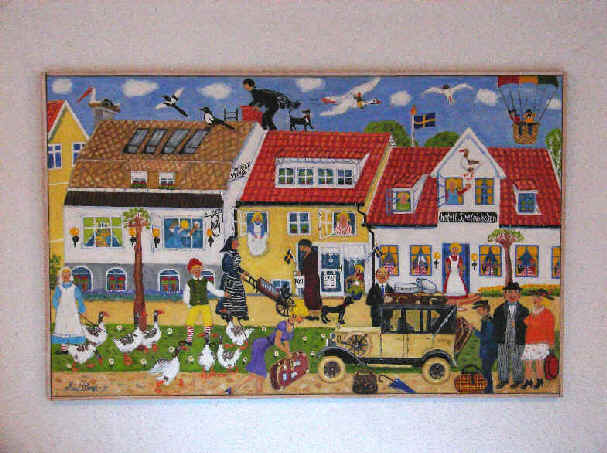
A
representation of the town of Skanor, adjacent to Falsterbo,
where we stay during our tour in southern Sweden,
depicting people, birds, our hotel (on the right), and the Swedish flag.
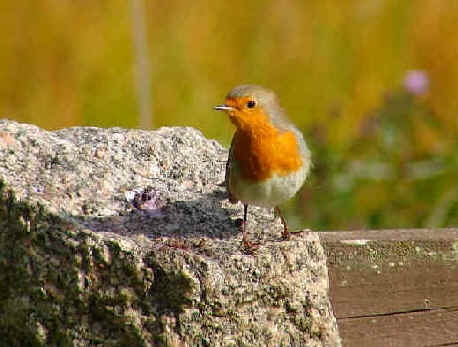
A European
Robin
(photo by James Scheib,
during the Sep '07 FONT Sweden tour)
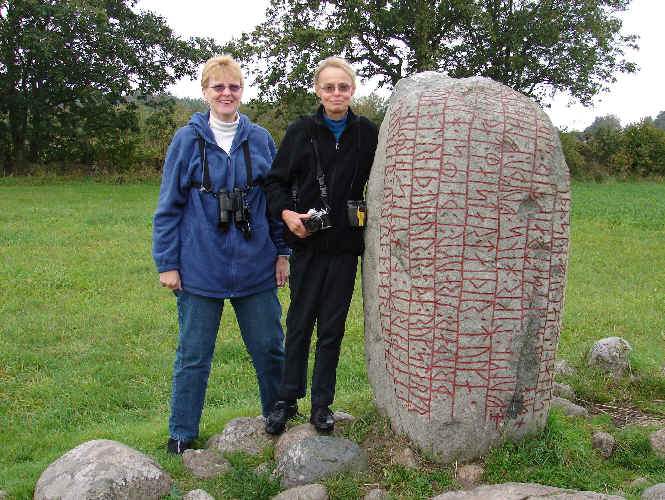
Two FONT Sweden '07 tour
participants,
both named Sharon,
on Oland Island
(photo by James Scheib)
The following narrative of the FONT Sep '07 Sweden Tour was written by Armas Hill, leader of the tour:
Our annual early fall
tour in Sweden, conducted September,
22-28, 2007, was at a prime time for a fascinating phenomenon - the
southbound migration of birds.
We went to two prime places to see it:
Falsterbo and Skanor,
at the southernmost tip of Sweden, and a long, narrow island called Oland,
in the Baltic off the southeastern coast of Sweden.
The bird migration that we witnessed during this tour was again extraordinary,
as it has been for us in previous years.
At Falsterbo, somewhere between 1 and 3
million birds, on their southward migration, are tallied each year from August
through October. The migrants are of a good variety, including an assortment of landbirds,
shorebirds (or waders), waterbirds of various
sorts, and raptors. Given the right weather conditions, Falsterbo can be
particularly good for all of these groups, and especially good for raptors.
During our days at Falsterbo, that last week
of September, there were always birds about. Early in the morning, overhead a
continuous stream of Chaffinches with some Bramblings flew by,
while, at times, some other similar birds included: Greenfinch, Goldfinch,
Linnet, Siskin, Redpoll, and Serin (these last two species
uncommon in southern Sweden). Some of the birds in the sky above were easily
visible, such as tight flocks of Wood Pigeons, with some Stock Pigeons
among them. Other birds flying by overhead were detected by their flight-calls
such as Woodlarks, Skylarks, and Pipits.
Migrating birds go in masses, particularly in the morning, to the tip of the
peninsula at Falsterbo. At that tip, there's
a golf course. But, because such a place is not private property in Sweden,
birders can walk there, in order to be with the masses of birds, as long as they
stay on the paths and don't go in the way of the golfers. Along the edge of the
golf course, by the sand dunes and the pools and sea beyond, there are bushes
that are, during mornings when the migration is good, filled with Blue Tits.
Flocks come and go, into and out of those bushes, and that they did for us
during our tour. On the pools and sea beyond, there was an assortment of ducks
and geese of various species.
By the golf course, there's an old lighthouse dating from the 1700's, and by it,
a grove of mostly pines, but also some deciduous trees. In those trees, during
the late September migration, there are (and were, for us) numbers of European
Robins, Goldcrests, Chiffchaffs, and other small landbirds.
In the sky above the golf course, the bushes, dunes, lighthouse, and trees, as
the autumn days proceed, there are raptors in the sky, We saw many during
our days at Falsterbo. Most common were Eurasian Sparrowhawks, but also
there were numerous Red Kites and Common Buzzards. The plumage of
the Buzzard, Buteo buteo, is quite variable. Some of those hawks
are light. Others are dark. We saw both, and many with shading in between.
Mid-day, during our last day at Falsterbo, just as we were about to leave, a White-tailed
Eagle was overhead with the other raptors.
Skanor is the sister-town of Falsterbo. It's
a nice little village, where we spent our nights in southernmost Sweden. Birding
can be good in and by Skanor, and it was for us. One morning, by the church and
cemetery, the bushes and trees were filled with small birds. One could have
thrown a stone from there to the nearby marshland filled with reeds. In this
perfect "edge" habitat, small birds abounded when we were there. There
were many Chiffchaffs, some Black Redstarts, and a nice number of European
Robins, in addition to various tits and finches. So many birds at one place,
as they were perched in the sunlight, was wonderful.
Also good, nearby in Skanor, by the water's
edge, we had a wonderful time along a concrete wall and stone jetty, adjacent to
a small harbor where boats were docked. As we walked about, that morning, along
the wall and the jetty, there were many wheatears, wagtails, and pipits.
The Northern Wheatears would continue on their way to Africa. There were
two species of Wagtails: White and Grey. Most were the White
Wagtail, a bird that's always wonderful to watch. The Pipits were
mostly Meadow, but there were also some Eurasian Rock. All of
these birds, in total, dozens of them, were feeding insects by the water, along
the shoreline and within the rocks. By the jetty, a large flock of Barn
Swallows was also feeding on insects in the air above the water. All of
these feeding birds were filling up to continue their migration, some, such as
the wheatears, to Africa, and others almost as far to the Mediterranean.
All of the birds with us there that morning would soon leave Sweden, except for
maybe the very little and shy Winter Wren that would periodically appear
from between the rocks.
Always, at places such as Falsterbo and Skanor,
where birds migrate, in addition to those that are common, there can be some not
so. And there's always the chance for a bird that's not at all expected.
As we were standing one morning, at the end of the golf course at the tip of the
peninsula in Falsterbo, a bird in that
unexpected category appeared in the sky above us. It was a Black Woodpecker,
a large member of the same genus as the American Pileated Woodpecker.
Somewhat confused for a while, when the bird saw so much water ahead of it on
all sides, it flew about above us for a bit, out in the open where there were no
trees, before it flew away. Black Woodpeckers are usually to be found in
among the trees, in the forest.
We'll now shift away from Falsterbo, to the other place that we enjoy so much
during our Sweden tours, Oland Island:
The southbound migration of birds on that island with the odd name, in the
Baltic Sea off the southeast coast of Sweden is also, during late September,
very good indeed.
But there are some notable differences between the migrations on Falsterbo and
Oland. On the latter, cranes and geese, for example, are much more in evidence.
And traveling south along the coasts of the long island, there can be a
continual processions of waterbirds. For example, during one of our days
on Oland, thousands of Common Eiders were flying, flock after flock, in
their way south. One morning, those people who were counting birds there told us
that 35,000 Common Eiders were tallied before 10am.
As noted, Oland is long, over a hundred miles, from north to south. And it is
narrow, east to west. On it, there's only one very small city. And there are but
a few towns, all small. Some are with one store, some are without. However,
there are, throughout the island, many barns and farmhouses, virtually all of
them well-maintained and all picturesque. These scenes throughout the island
make it like seem one big post card. Fitting well in such scenes of countryside
settings, was the attractive bed-and-breakfast where we stayed. Our time on
Oland, as we traveled about from one end of the island to the other, along the
coasts and in between, was for us rather like a couple days out of the
"real world" as most of us otherwise know it.
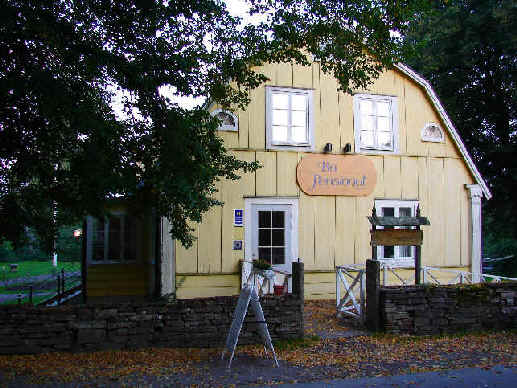
The quaint
little hotel where the FONT tour group stayed
on Oland Island in September 2007
(photo by James Scheib)
Bird migration can be good at
many places on Oland Island, but it's best
at the southern tip, where, as they are at Falsterbo, the birds are more
concentrated and obvious. By the lighthouse, in the bushes and small trees by
the few buildings, and on the grassy meadow, as well as along the gravelly
coastline and in the marsh, there are many birds to be seen. As the birds
migrate, day to day, and sometimes hour to hour, the cast of avian travelers
changes. Those bushes and low trees, at the south end of the island, can
literally overflow with a big number of little birds. Among those little ones,
is one of Europe's smallest birds, the Goldcrest. There can be many, as
we saw, long with with many Robins, Warblers, and some Flycatchers.
With dozens of these birds in the bushes, a flock of Song Thrushes was
feeding on the small lawn beneath them. A predator for such birds, the Merlin,
flew by in the sky above them.
The large birds that stage a few miles to the north, notably the cranes
and the geese, mentioned earlier, are among the birds that were most
enjoyable for us to see.
A favorite were the flocks of cranes. We saw hundreds of them, that had
just recently left their nesting grounds further north in Scandinavia. They
gather together on Oland before flying south to where they'll winter in Spain.
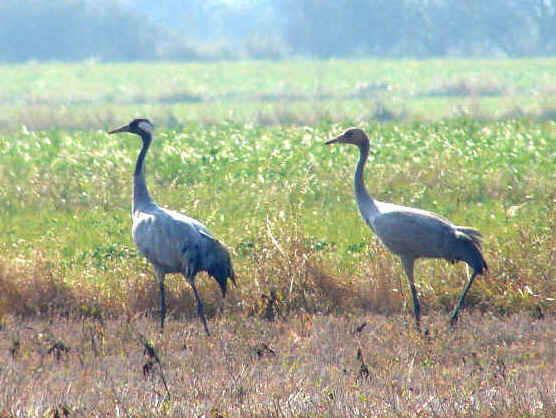
An adult
Common Crane (left) with a young bird of the year (right)
photographed on Oland Island during the FONT Sept '07 Sweden Tour
(photo by James Scheib)
Geese of a few species
also stage in late September/early October on Oland Island. We saw flocks of Greylag,
Barnacle, and Brant. Among one large flock of geese, we saw on Egyptian
Goose, an African species that's been feral for years in Holland.
On and by farm fields on Oland, there can be (and were, for us) flocks of
migrating finches, such as Chaffinches, Bramblings, Linnets, and Yellowhammers.
On one particular field, in addition to the geese, gulls, lapwings, corvids,
and finches that were feeding on the ground, there was a large flock of
Starlings. Among those Common Starlings, there was one Rosy
Starling, a bird normally in eastern Europe and nearby Asia.
Woodpeckers that we encountered on Oland
were both the Great and Lesser Spotted, and a nice prize, the Eurasian
Green.
Waders (or "shorebirds") that we
encountered on Oland were, in addition to
the Northern Lapwing, already mentioned, these other Plovers: Common
Ringed, Grey, European Golden - as well as these: Pied Avocet (a
nice one for us to see that late in the season), Ruff, Dunlin, Common
Redshank, Common Greenshank, Eurasian Curlew, and Bar-tailed
Godwit.
At both Falsterbo, and at the southern tip
of Oland, at a place called Ottenby,
there have been, for years, "bird stations", where the passerines
are netted and ringed. In Europe, what's called "bird banding' in North
America, is called "ringing". This activity has been conducted at both
stations since the 1940's, and at both places, since then, about a million birds
have been ringed. During one of the days of our tour, "bird number One
Million" was ringed at the Ottenby bird station. It was a European Robin.
For us, the dapper, to say the least, European Robin was one of the birds
we liked the best. We saw that bird so well, so many times. Not as many times
"as a million", but, for us, many times. Even so, we never tired of
seeing it.
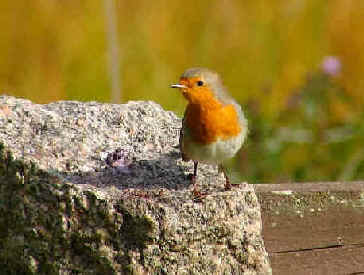
A European
Robin
photographed during the FONT 2007 Tour in Sweden
(photo by James Scheib)
The European Robin was
just one of 113 species of birds during our September 2007 Sweden Tour. Of
those, 76 species were recorded at Falsterbo
and Skanor, and 87 species were found on
Oland Island.
Given in the following two lists, in order of abundance, are rankings of the top
25 bird species that have been tallied in passage (or on migration) at firstly
Falsterbo, and then Ottenby on Oland Island, in the late-Summer & the Fall.
Both lists reflect the counts since records began being kept, at both places,
over 50 years ago, in the 1940's.
The NUMBERS given are YEARLY AVERAGES.
The 2 species of Chaffinch and Brambling are combined as the birds travel in
mixed flocks of both. Generally, the proportion of Chaffinch to Brambling can be
as high as 9 to 1.
At FALSTERBO:
1) Chaffinch/Brambling: 1,000,000
2) Woodpigeon: 180,000
3) Starling: 180,000
4) Common Eider: 75,000
5) Linnet: 46,000
6) Yellow Wagtail: 36,000 (migrates before our annual
tours conducted in late Sept or early Oct)
7) Barn Swallow: 32,000 (mostly before our tours)
8) Greenfinch: 27,000
9) Western Jackdaw: 26,000
10) Siskin: 23,000
11) Tree Pipit: 22,000 (mostly before our tours)
12) Fieldfare: 13,000
13) Common Buzzard: 11,000
14) Redwing: 10,000
15) Meadow Pipit: 9,900
16) Rook: 9,200
17) Hooded Crow: 9,200
18) Blue Tit: 8,800
19) Stock Pigeon: 7,800
20) European House Martin: 7,300 (migrates before our tours)
21) Black-headed Gull: 6,700
22) European Honey Buzzard: 6,500 (mostly before our tours)
23) Eurasian Sparrowhawk: 6,100
24) Sand Martin: 5,200 (before our tours)
25) Yellowhammer: 5,100
total: a yearly average of 1,800,000 birds, with some other species, less
common, not listed here
At OTTENBY, at the southern end of OLAND ISLAND:
1) Swift: 110,000 (migrates before our annual tours
conducted in late Sept or early Oct)
2) Common Starling: 60,000
3) White Wagtail: 23,000
4) Chaffinch/Brambling: 18,000
5) Dunlin: 17,000
6) Linnet: 16,000
7) Eurasian Wigeon: 11,000
8) Common Eider: 10,000 (counts for this species have
greatly increased in recent years due to a different, improved counting
technique along the coastline of the island)
9) European House Martin: 9,800 (migrates before our
tours)
10) Eurasian Oystercatcher: 6,600 (migrates before our tours)
11) Common Black-headed Gull: 6,400
12) Sand Martin: 6,300 (migrates before our tours)
13) Barn Swallow: 5,600 (mostly before our tours)
14) Common Shelduck: 4,000 (mostly before our tours)
15) Yellowhammer: 3,600
16) Eurasian Siskin: 3,400
17) Common /Arctic Terns: 3,300 (migrate before our tours)
18) Greenfinch: 3,200
19) Eurasian Skylark: 3,000 (mostly before our tours)
20) Northern Pintail: 3,000
21) Tree Pipit: 3,000 (mostly before our tours)
22) Stock Pigeon: 2,700
23) Black Scoter: 2,300
24) Eurasian Curlew: 2,200 (mostly before our tours)
25) Northern Lapwing: 2,200
total: a yearly average of about 400,000 birds, with some species, less common,
not listed here.
Watching raptors migrate through Falsterbo
has been, over the years, a highlight during our FONT Sweden tours. That
migration, during many September and October days, is very apparent.
In all, 21 species of raptors have been recorded migrating south at Falsterbo
during the 30 years from 1973 to 2003. They are listed below, in order of
abundance, with the average number of individuals per year, and maximums &
minimums:
1) Eurasian
Sparrowhawk: 16,183 max: 30,072 in 2000; min: 3,712 in 1973
2) Common Buzzard: 13,860 max: 18,502 in 1999;
min: 7,430 in 1986
3) European Honey Buzzard: 7,486 max: 11,076 in
1974; min: 2,127 in 2001
4) Rough-legged Buzzard (or Hawk): 932 max: 1,619 in
1978; min: 154 in 2003
5) Western Marsh Harrier: 550 max: 1,078 in 2000;
min: 113 in 1978
6) Red Kite: 508 max: 1,445 in 2003; min: 33 in
1973
7) Common Kestrel: 475 max: 953 in 2003; min: 192
in 1995
8) Northern (or Hen) Harrier: 268 max: 379 in
2003; min: 107 in 1998
9) Osprey: 241 max: 413 in 2000; min: 110 in 1980
10) Merlin: 204 max: 417 in 2003; min: 98 in 1979
11) Eurasian Hobby: 48 max: 71 in 1986 & 2001; min: 16 in
1996
12) Northern Goshawk: 33 max: 106 in 1991; min: 0 in 2000
13) Peregrine Falcon: 22 max: 76 in 2003; min: 2 in 1977
& 1978
14) White-tailed Eagle: 10 max: 47 in 2003; min: 0 several
years
15) Black Kite: 7 max: 19 in 2003; min: 0 several years
16) Montagu's Harrier: 7 max: 19 in 1990; min: 0 several
years
17) Lesser Spotted Eagle: 3 max: 14 in 1988 & 1989; min:
0 several years
18) Pallid Harrier: 2 max: 11 in 2001; min: 0 several years
19) Golden Eagle: 2 max: 8 in 1981; min: 0 several years
20) Red-footed Falcon: 2 max: 6 in 1995 & 2001; min: 0
several years
21) Greater Spotted Eagle: 1 max: 5 in 1998; min: 0 several
years
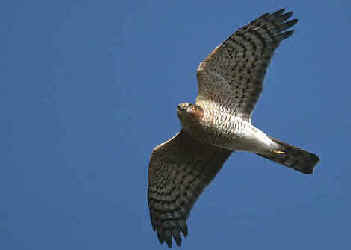
The Eurasian Sparrowhawk is
overall
the most common migrating raptor at Falsterbo.
As certainly indicated in this narrative, a substantial number of records have
been kept relating to the bird migration in Sweden during the last 60 years.
Rather interesting have been the trends, especially during the most recent
decades, that may relate to the global warming that's been taking place in
Sweden as it has in other parts of the world.
Some species, during their southbound migration, have recently been peaking
later in the season than they have in the past. Such species are given below,
noting how many days later their median date has been at Falsterbo
in the 2000's (thus far) compared to the 1970's:
Greylag Goose: 33 (from Sep 21 to Oct 24)
Red Kite: 9 (from Sep 28 to Oct 7)
Whooper Swan: 8 (from Oct 30 to Nov 7)
Hen Harrier: 8 (from Oct 4 to Oct 12)
European Goldfinch: 8 (from Oct 21 to Oct 29)
Common Crane: 6 (from Sep 18 to Sep 24)
Stock Pigeon: 6 (from Oct 4 to Oct 10)
Western Jackdaw: 4 (from Oct 17 to Oct 21)
Common Buzzard: 3 (from Oct 5 to Oct 8)
Yellowhammer: 3 (from Oct 28 to Oct 31)
* * * * * * * * * * * * * * * * * * * * *
When we travel between Falsterbo
and Oland, it's about a 5-hour drive through
the Swedish countryside. We usually stop for lunch, about midway, near the
little town of Almhult. We did again this
year, having a meal such as Swedish meat balls with vegetables. The food was
good and all was well. It was a sunny, bright, and warm fall day. Just outdoors,
in the small trees, as we ate, some Great Tits were flitting about. It's
always nice, during a stop, when there's a bird or two with us, and dapper ones
at that.
But what was really interesting was that later, that evening, in the small
quaint hotel where we stayed, I read in a book that Carl
Linnaeus was born back in 1701 on a farm by Almhult,
very near where earlier in the day we had eaten our Swedish lunch.
Later, during our trip that day, in the afternoon, we stopped for gas in the
small city of Vaxjo. I also read that
evening, in that same book, that Linnaeus had gone to primary school in Vaxjo,
the same city where, along the way, we got gas and a snack.
In that part of Sweden, away from the towns and small cities, it's very much a
land of forests, lakes, farms, and fields.
Why would a man back in the 1700's in such a remote part of the world - and away
from the major cities of the time - be of interest to us, nowadays, on a birding
tour in 2007?
And who was this Carl Linneaus, anyway?
He's notable because every time that we look in a bird book we see something for
which he has been responsible, during more than the last two centuries, and for
which he'll continue to be, probably forever.
In 1735, Carl Linneaus, the Swedish doctor
and botanist, published the first edition of his "Systema naturae",
which contained the basis of the modern taxonomy that's used today, for both
flora and fauna.
During former centuries, living things had been classified by their function and
behavior, rather than according to their form and structure. As an example, some
birds were roughly categorized as simply "waterbirds".
Firstly, as noted, Linnaeus was a botantist. In 1753, he published his "Species
Plantarum", and the next year, "Genera Plantarum".
The two volumes established the principle of international recognition of
scientific plant names. Since his work, classification has extensively been
improved, and still yet undergoes modification. But it was from Linnaeus's work
that an enormous catalog grew that enabled naturalists for the first time
to proceed with the confidence that he or she was working with a plant whose
identity had already been determined.
Linnaeus had worked out a binomial system of nomenclature in which two words,
mostly the internationally understood Latin, or sometimes Greek, were used to
name all plants. First as to the genus and then the species, the two designated
words would define a unique and natural unit.
No longer, as in the past, would a single Latin word designate a particular
plant, nor would there be any more cumbersome conglomerations of Latin words.
For example, the Cherry tree, that Linnaeus simplified to "Physalis
angulata" had been: "physalis amno ramisissime ramis angulosis glabris
follis dentoserratis", meaning "bladder-footed annual, many-branches
with angled branches and smooth, deeply toothed leaves".
By 1758, Linnaeus published his 10th edition
of "System naturae", in which he established the same
system, as he had for plants, of taxonomic classification for zoologists in
relation to birds and mammals. In it, there was, for those creatures, the first
international "name bank" for scientists to use, with the same
binomial structure, of mostly Latin and sometimes Greek, giving first genus and
then the species. Over the years, some names have changed, and there has been
some modification, but the system put in place by Linnaeus has remained the
same.
Overall, Linnaeus's taxonomic system caught on quickly in much of Europe.
However, there were some scientists who adapted it with the ulterior motive of
renaming well-known birds and animals and then getting credit for their
description. And British naturalists, on the whole, ignored it as they preferred
to stay with the English bird names that were used by the English naturalist John
Ray, in his "Ornithologieae libri tres" in
1676.
It was not until 1922 that there was a more standard worldwide agreement
regarding ornithological scientific names and taxonomy, only after an
International Commission on Nomenclature had been founded in 1901.
In his "System naturae", Linnaeus listed 564 species
of birds, in 85 genera (the plural of genus). Of course, not all of
these were birds of Sweden, or even Europe.
Linnaeus, in his 1758 work, done in Sweden, described such birds as the Ostrich
of Africa, the Golden Pheasant and the Indian
Peafowl of Asia, and a number of species
from the Neotropics, including various macaws,
parrots, toucans, and even the Harpy Eagle. He also described some North
American birds based on collections and accounts by various people
including Peter Kalm, a Swede who traveled
in parts of eastern North America procuring information regarding nature and
sending it back to Linnaeus in Sweden. Also, an especially pertinent source for
Linnaeus regarding North American birds was the work, "A Natural
History of Florida, Carolina, and the Bahama Islands", published in
1754, by the early American naturalist, Mark Catesby.
North American species described by Linnaeus included the Whooping Crane
and the Ivory-billed Woodpecker. (This, of course, was years
before there was a United States of America.)
Back when it began, in 1735, "System naturae" was only a
slim pamplet. That first edition was actually published in the Netherlands where
Linnaeus lived at that time, about a year. It was but 11 pages. During years
that followed, as "System naturae" grew into a
mutivolume work, Linnaeus's idea's evolved, as more & more plant and animals
specimens were sent to him from all over the globe. (Some bird specimens that
he received from the recently-explored Americas as well as Asia & Africa,
from which he described and named species, were to referred to in the last
paragraph.)
During those decades, Linnaeus had great pride in his work. In fact, he was a
bit vain as he liked to say in Latin: "Deus creavit, Linnaeus disposuit".
In English, that means "God created, Linnaeus organized".
Many of the birds that we saw during our September '07 Sweden tour were
described by Linnaeus, either back in 1758 in the 10th edition of "System
naturae", or later as additions in subsequent editions in 1761
& 1766.
Oddly, some other birds during our tour were not so described by Linnaeus - even
though one might think they would have been (such as the Mute Swan and
the Herring Gull, both of course common and obvious birds in
Sweden).
These following birds, seen during our Sweden Sep '07
tour, were described by Linneaus
in 1758. Given first is the current scientific name (usually, but not always,
that given by Linnaeus), followed by the Swedish common name (used by those
at the time of Linnaeus & since in "their part of the world"), and
then lastly, the current English name.
1) Perdix perdix, Rapphona, Grey Partridge
2) Pasianus colchicus, Fasan, Common Pheasant
3) Podiceps cristatus, Skaggdopping, Great
Crested Grebe
4) Phalacrocorax carbo, Storskarv, Great
Cormorant
5) Ardea cinerea, Hager, Grey Heron
6) Anser anser, Gragas, Greylag Goose
7) Branta bernicla, Sadgas, Brant Goose
8) Branta canadensis, Kanadagas, Canada Goose
(even though it was a North American, and not a Swedish bird)
9) Tadorna tadorna, Gravand, Common Shelduck
10) Anas platyrhynchos, Grasand, Mallard
11) Anas strepera, Snatterand, Gadwall
12) Anas penelope, Blasand, Eurasian Wigeon
13) Anas acuta, Stjartand, Northern Pintail
14) Anas clypeata, Skedand, Northern Shoveler
15) Anas crecca, Kricka, Eurasian Teal
16) Aythya ferina, Brunand, Common Pochard
17) Aythya fuligula, Vigg, Tufted Duck
18) Somateria mollissima, Ejder, Common Eider
19) Bucephala clangula, Knipa, Common Goldeneye
20) Mergus serrator, Smaskrake, Red-breasted Merganser
21) Haliaeetus albicilla, Havsorn, White-tailed Eagle
22) Milvus milvus, Glada, Red Kite
23) Accipiter nisus, Sparvhok, Eurasian Sparrowhawk
24) Accipiter gentilis, Duvhok, Northern Goshawk
25) Buteo buteo, Ormvrak, Common Buzzard
26) Circus aeruginosus, Brun karrhok, Western Marsh Harrier
27) Falco columbarius, Stenfalk, Merlin
28) Falco tinnunculus, Tornfalk, Common Kestrel
29) Gallinula chloropus, Rorhona, Common Moorhen
30) Fulica atra, Sothona, Eurasian Coot
31) Grus grus, Trana, Common Crane
32) Recurvirostra avosetta, Skarflacka, Pied Avocet
33) Vanellus vanellus, Tofsvipa, Northern Lapwing
34) Pluvialis squatarola, Kustpipare, Grey Plover
35) Pluvialis apricaria, Ljungpipare, European Golden Plover
36) Charadrius hiaticula, Storre strandpipare, Common Ringed Plover
37) Actitis hypoleucos, Drillsnappa, Common Sandpiper
38) Calidris alpina, Karrsnappa, Dunlin
39) Tringa totanus, Rodpena, Common Redshank
40) Philomachus pugnax, Brushane, Ruff
41) Numenius arquata, Storspov, Eurasian Curlew
42) Limosa lapponica, Myrspov, Bar-tailed Godwit
43) Larus fuscus, Silltrut, Lesser Black-backed Gull
44) Larus marinus, Havstrut, Great Black-backed Gull
45) Larus canus, Fiskmas, Common (or Mew) Gull
46) Cepphus grylle, Tobisgrissla, Black Guillemot
47) Columba oenas, Skogsduva, Stock Dove
48) Columba palumbus, Ringduva, Common Wood Pigeon
49) Apus apus, Tornsvala, Common Swift
50) Picus viridis, Grongoling, European Green Woodpecker
51) Dendrocopos major, Storre hackspett, Great Spotted
Woodpecker
52) Dendrocopos minor, Mindre hackspett, Lesser Spotted
Woodpecker
53) Dryocopus martius, Spillkraka, Black Woodpecker
54) Garrulus glandarius, Notskrika, Eurasian Jay
55) Nucifraga cryocatactes, Notkraka, Spotted Nutcracker
56) Pica pica, Skata, Eurasian Magpie
57) Corvus corax, Korp, Common Raven
58) Corvus frugilegus, Raka, Rook
59) Corvus cornix, Kraka, Hooded Crow
60) Corvus monedula, Kaja, Western Jackdaw
61) Parus major, Talgoxae, Great Tit
62) Cyanistes caerulus, Blames, Blue Tit
63) Periparus ater, Svartmes, Coal Tit
64) Poecile palustrus, Entita, Marsh Tit
65) Hirundo rustica, Ladusvala, Barn Swallow
66) Aegithalos caudatus, Stjartmes, Long-tailed Bushtit (has
been called Long-tailed Tit)
67) Lullula arborea, Tradlarka, Woodlark
68) Alauda arvensis, Sanglarka, Eurasian Skylark
69) Regulus regulus, Kungsfagel, Goldcrest
70) Troglodytes troglodytes, Gardsmyg, Northern (or Winter)
Wren
71) Turdus merula, Koltrast, Common Blackbird
72) Turdus pilaris, Bjorktrast, Fieldfare
73) Sturnus vulgaris, Stare, Common Starling
74) Sturnus roseus, Rosenstare, Rosy Starling
75) Erithacus rubecula, Rodhake, European Robin
76) Saxicola rubetra, Buskakvatta, Whinchat
77) Oenanthe oenanthe, Stenskvatta, Northern Wheatear
78) Anthus trivialis, Tradpiplarka, Tree Pipit
79) Anthus pratensis, Angspiplarka, Meadow Pipit
80) Motacilla cinerea, Sadesrla, White Wagtail
81) Passer domesticus, Grasparv, House Sparrow
82) Passer montanus, Pilfink, Eurasian Tree Sparrow
83) Fringilla montifringilla, Bofink, Common Chaffinch
84) Fringilla montifringilla, Bergfink, Brambling
85) Carduelis carduelis, Steglits, European Goldfinch
86) Carduelis spinus, Gronsiska, Eurasian Siskin
87) Carduelis flammea, Grasiska, Common Redpoll
88) Carduelis chloris, Gronfink, European Greenfinch
89) Carduelis cannabina, Hampling, Eurasian Linnet
90) Plectrophenax nivalis, Snosparv, Snow Bunting
91) Emberiza calandra, Kornsparv, Corn Bunting
92) Emberiza citrinella, Gulsparv, Yellowhammer
93) Emberiza schoenicius, Savsparv, Common Reed Bunting
These additional birds, seen during our September '07
tour, were also described by Linnaeus,
but later:
in 1761:
94) Aythya marila, Bergand, Greater Scaup
in 1766:
95) Alopochen aegyptiaca, Nilgas, Egyptian Goose, (we saw a
vagrant during our tour, among a mixed flock of wild geese, Grey Lag and
Barnacle)
96) Circus cyaneus, Blakarrhok, Northern Harrier
97) Larus ridibundus, Skrattmos, Common Black-headed Gull
98) Serinus serinus, Gulhampling, European Serin
And so, that's 98 of the 114 species of birds seen during the FONT September '07
Sweden that were described to science in the 1700's in Sweden
by Carl Linnaeus.
Those birds, during our tour, that were not described by Linnaeus included:
Little Grebe (described by the Russian scientist, Peter Simon
Pallas in 1764)
Mute Swan (somehow not described until 1789, by Johann Friedrich
Gmelin; at that time, that German scientist had taken over the work of Linnaeus,
with the 12th edition of "Systema naturae")
Barnacle Goose (somehow not described until 1803)
Black Kite (described in 1783; the one bird, by the way, that we
saw in Sept '07 was the first for a FONT tour in Sweden)
Spotted Redshank (described by Pallas in 1764)
Common Greenshank (described Gunnerus in 1767)
Herring Gull (described by Pontoppidan in 1763 - seems as if
Linnaeus "by-passed" some of the gulls) (A note regarding Mr.
Pontoppidan follows, at the end of this narrative. He is also credited, by the
way, with describing the Rough-legged Hawk.)
Sandwich Tern (described John Latham, of England, in 1787)
Common (or Feral) Pigeon
(Linnaeus apparently did not heed the Feral Pigeon; the wilder form from cliffs
further south in Europe was described in 1789 by Gmelin)
Eurasian Collared Dove (described in 1838, but in those days
this bird occurred in Asia; it only arrived into Europe, spreading and becoming
common there in mid 20th Century; of the birds we saw during our Sweden tour,
the latest to be described to science)
Song Thrush (described in 1831, another "late" one in
that regard)
Black Redstart (this bird was first described in 1774 from an
Asian specimen)
Common Chiffchaff (described in 1817; one of a few
similar-looking Phylloscopus warblers)
European Rock Pipit (described in 1798; quite similar to the
Water Pipit that's common in Europe)
Grey Wagtail (described in 1771 by a man in England named
Marmaduke Tunstall, who also described, in his same publication that year, the
Peregrine Falcon)
Not many birding tours anywhere (or maybe any), would have as high a
percentage of birds found that had been described by founder of modern
ornithological taxonomy, Carl Linnaeus.
14 of the bird species list
above, as described by Linnaeus, have
scientific names in which the genus and the species, that is the first and
second names, are the same. That also would likely be a high number for birds in
that category. These birds were:
Perdix perdix, Grey Partridge
Anser anser, Greylag Goose
Tadorna tadorna, Common Shelduck
Milvus milvus, Red Kite
Buteo buteo, Common Buzzard
Grus grus, Common Crane
Vanellus vanellus, Northern Lapwing
Apus apus, Common Swift
Pica pica, Eurasian Magpie
Oenanthe oenanthe, Northern Wheatear
Regulus regulus, Goldcrest
Troglodytes troglodytes, Winter Wren
Carduelis carduelis, European Goldfinch
Serinus serinus, European Serin
11 of these birds even have 3 names that are the same as the subspecies seen in
Sweden was the first to be described. The other 3 species in the list above are
monotypic, that is they have no subspecies.
The birds with 3 identical scientific names include:
Perdix perdix perdix, Grey Partridge: 7 other subspecies, later
described, in Eurasia
Anser anser anser, Greylag Goose: one other subspecies in Asia, described
in 1871
Milvus milvus milvus, Red Kite: one other subspecies only on the Cape
Verde Islands off Africa
Buteo buteo buteo, Common Buzzard: 10 other subspecies, later described,
across Eurasia
Grus grus grus, Common Crane: one other subspecies in eastern Asia,
described in 1894
Apus apus apus, Common Swift: one other subspecies, breeding in Asia,
described in 1870
Pica pica pica, Eurasian Magpie: 10 other subspecies, later described, in
Europe, Asia, & Africa
Oenanthe oenanthe oenanthe, Northern Wheatear: 3 other subspecies, later
described, in Eurasia & Africa
Regulus regulus regulus, Goldcrest: 12 other subspecies, later described,
one as recently as in 1954
Troglodytes troglodytes troglodytes, Winter Wren: as many as 40 more
subspecies later described in Eurasia, Africa, and North America
Carduelis carduelis carduelis, European Goldfinch: 13 other subspecies.
later described, in Eurasia, including one as recently as in 1953 in Siberia (as
to the bird's common name, it should be called the "Eurasian
Goldfinch")
In birds, such as these 13 species, the first described subspecies is called the
nominate. Of the 87 other species, from the list of 98 above, described by Linnaeus,
68 are also nominate subspecies, that is with other subspecies that followed
them. The other dozen or so species of the 98 are monotypic, that is, again,
without subspecies.
Among the 68 nominate subspecies, there's one that was particularly interesting.
During our Sept '07 tour, as we were at the north end of Oland
Island, at a very peaceful and quiet spot along the coast, a small
black-and-white bird was first on a rock, and then on the surface of the water.
Then, it disappeared. The bird was a Black Guillemot.
There are 5 populations, or subspecies, of Black Guillemots, throughout
the northern reaches of the Northern Hemisphere, in places as far-flung as
Alaska, Canada, Greenland, Iceland, the Faroe Islands, Great Britain, and Maine
in the US. But the single bird that we saw at the north end of Oland Island was
of the nominate race limited only to the Baltic, and the only subspecies that
was described by Linnaeus, back in 1758.
Linnaeus has been (he was, and still is)
with an impact on all of us regarding names, as he was (and still is) "the
father of modern taxonomy".
The role that he's had with nomenclature over the centuries is intriguing, and
maybe ironic, because even with himself there's a story as to Linnaeus's names.
He had many. Variants included: "Carl
Linnaeus", "Carolus Linnaeus", "Carl von Linne",
and sometimes just "Carl Linne".
There's often some confusion about his real Swedish name, as opposed to the
Latinized form "Carolus Linnaeus"
that he most often used when he published his scientific works in Latin.
To begin with, during the time when Linnaeus lived, most Swedes had no surnames.
His grandfather was named Ingemar Bengtsson (son
of Bengt), according to Scandinavian tradition.
His father was known as Nils Ingemarsson (son
of Ingemar).
Only for purpose of a registration, for example, to enter a university, did one
need a surname. When Linnaeus's father entered the academic world, he gave
himself the Latin surname, Linnaeus,
referring to a large linden (a type of lime) tree on his property.
When he gave the name Carl to his son, the boy's name became Carl
Linnaeus because his father had a surname.
When the young student, Carl Linnaeus,
enrolled in school, he registered as "Carolus
Linnaeus", having both of his names in Latin rather than
Swedish.
In later life, after he was nomination to be a nobleman by the Swedish king was
confirmed in 1761, he took the name Carl von Linne.
"Linne" was a shortened form of Linnaeus. "von" signifies
ennoblement. This name is less suitable in relation to the works that he
published prior to 1761. In fact, on the title page of the his second edition of
"Species plantarum", published in 1762, the name of the
author is given as "Carolus Linnaeus",
but in its genitive form "Caroli Linnaei".
After that, however, it was always printed as either "Carolus
a Linne" or "Carl von Linne".
After having a stroke in 1774, Linnaeus died in January 1778.
During his life, in addition to his works in relation to taxonomy and the
classification of flora and fauna, Linnaeus practiced medicine, specializing in
the treatment of syphilis. And, regarding something else, he's continued to
have, until this day, yet another impact on the lives of many people. In about
1743, Linnaeus designed the thermometer
scale that's now in use by reversing what had been invented by Anders
Celsius. 100 degrees on that scale had been the melting point of ice,
and 0 degrees had been water's boiling point.
Years before, when Linnaeus was a university student at Uppsala
in Sweden, he met the astronomer, Celsius,
who in fact helped him, during some rough times, by offering him room and board.
Celius was quite impressed with the young student's knowledge and botanical
collections.
In the middle of the summer of 1749, Linnaeus
visited Falsterbo and
Skanor - walking about, I'm sure, at places where we did, but at a
different season, not when the bird migration would have been so much in
evidence. He wrote about his visit there in his book, "Skanska Resa":
" The country is flat and low-lying.... The ground is generally known as
the heath and is thin and overburdened with windborne sand."
Of Skanor, Linnaeus wrote: "It is
situated a couple musket shots from the north sea.. The road to the village from
the mainland can scarcely be seen and instead you drive along the beach when the
tide is out."
(Of course, travel in those days was by horse & cart.)
Linnaeus continued about Skanor: "If seeking a quiet retreat, one can
hardly find anywhere in Sweden quieter than this, for here no people of the
classes reside."
Of Falsterbo, he wrote: "It is even a
smaller village... Shifting sands have swept across all the lanes. The lantern (in
an iron basket hanging from a high pole) shines from the southernmost point
so that seafarers do not become wrecked on the reef that runs for a whole mile (10
kilometers)." (That's what "a mile" was in those days.)
Regarding the area, Linnaeus wrote about everyday life, the countryside and the
flora and fauna. He noted that he found amber, bog-myrtle, and fennel in
abundance, and what was lacking were rats, walnut trees, and forest. His
observations on the birdlife were few, although he noted that Oystercatchers
"patrolled all the beaches", and that Lapwings "flew in
profusion".
What a pity that Linnaeus did not visit Falsterbo and Skanor at the time of year
that we did, when there's such a large, obvious, and wonderful migration of
birds!
And now, here's the note, promised earlier, regarding Pontoppidan,
who lived at the same time as Linnaeus, but in neighboring Norway. He was
actually Bishop Erik Ludvigsen Pontoppidan.
It was mentioned a few paragraphs back that he described the Herring Gull and
the Rough-legged Hawk. He did so in his "Natural History of
Norway", published in 1755.
Also in that work, it's interesting that he wrote of a huge snake-like, maned
sea serpent, that had been seen passing a ship in the ocean off the coast of
Norway, in 1746. Commonly known at the time as the "kraken",
what the bishop was describing was a Giant Squid, a huge creature that to
this day has never been seen "alive and well" in the ocean. There
have, over the years, been occurrences of either sick individuals floating on
the surface of the sea, or washed up on shore. The Giant Squid, at about
50-feet in length, is larger than any other form of life known on Earth other
than 3 species of big whales.
In the water, from the coast,
during our September '07 Sweden Tour, of
course, we saw no maned sea serpant. But we did see the head of a Harbor Seal
in the Baltic Sea, as it peered at us.
Other mammals during our tour included: Fallow Deer (introduced
onto Oland Island centuries ago, on property that was once that of the king), Western
Roe Deer, Elk (called Moose in North America), Common
Pipstrelle (in migration on Oland), and the European Rabbit.
Like so many of the birds during our tour, these were described by Linnaeus
in the 1758 edition of "System naturae".
How good it was for us to bird and travel in Sweden,
that land of Linnaeus, in September 2007. We
look forward to going back again.